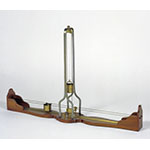Rotating machine that can be fitted with accessories to illustrate the effects of centrifugal force. The apparatus, described by Jean-Antoine Nollet in Leçons de physique expérimentale (Paris, 1743-1748), is mounted on a triangular table.
A vertical column held in place with fastening screws carries a frame holding a spoked wheel fitted with a handle. The wheel groove carries a cord that, guided by five sheaves, imparts a rotating motion to a pair of disks placed horizontally on the table. The cord tension can be adjusted by vertical shifts in the frame holding the wheel. Various accessories used for the experiments (carriages, oblique tubes, cords with small spheres) are screwed onto the disks. For example, a glass cylinder is placed at the center of a profiled board with two branching oblique tubes connected to two flasks at either end of the instrument. When the cylinder is filled with water and the apparatus is rotated, the centrifugal force drives the liquid up the tubes and fills the flasks. Provenance: Lorraine collections.











